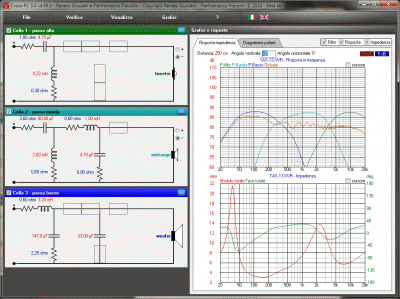Cross-PC 5.0
Cross-PC, created by Renato Giussani, the world’s first program of speakers simulation with passive filters available for all fans, had a remarkable success among diyers, audio professionals, as well as many installers Car Stereo.
Its success, mainly due to its ease of use and high reliability of the results offered, it’s growing up.
Introduced in April 1986, and born mainly with educational purposes, Cross-PC proved to be a formidable support for diyers, and not only to design their speaker systems.
The program is not meant to replace the testing procedure or to transform anyone into a skilled designer just by clicking the mouse on a series of buttons on the screen.
Instead, it is a software designed to help so that each user can be able to understand what are the right choices to design a loudspeakers system properly.
The Cross-PC, despite being a simple program and, even limited, in some ways, has become a “classic”, with which very few other programs can compete, in terms of usability and reliability of the results provided.
Early versions of the Cross were for Commodore-64 and DOS. His rewrite for Windows has not done anything but make it even more clear its teaching vocation, as well as simplify further use.
The program can, after changing the filter components or parameters of a speaker, immediately verify the effect on the response curves and impedance allowing even more to understand what you are doing.
“To understand how something works just build it, or simulate it through the computer that is now available to everyone.”
From this assumption of Renato Giussani the Cross-PC software was born, the CAD for fans of DIY loudspeakers systems and music played. The widespread availability of the first electronic computers made possible the design of a scientifically accurate and complex loudspeakers system , where the elements influence each other, before its physical realization.
Cross-PC is can be used even in “reverse engineering”, enhancing its didactic nature, to simulate and study a system already made by others, even by trademarks.
“We prefer that the program evolves slowly because this way we can better control every change. The strength of Cross-PC has always been the correspondence of simulations with measurable results on the finished project, this is the feature that certainly we want to keep. “







